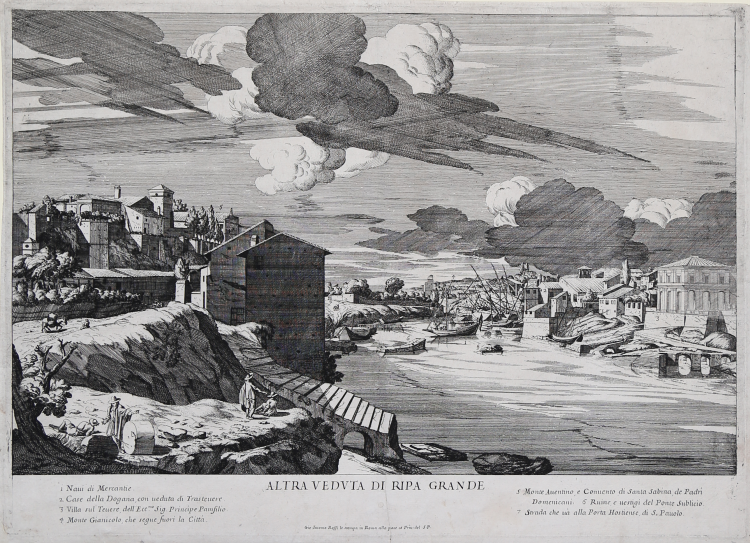



| Reference: | S23446 |
| Author | Giovanni Battista FALDA |
| Year: | 1660 ca. |
| Zone: | Tevere |
| Printed: | Rome |
| Measures: | 360 x 500 mm |


| Reference: | S23446 |
| Author | Giovanni Battista FALDA |
| Year: | 1660 ca. |
| Zone: | Tevere |
| Printed: | Rome |
| Measures: | 360 x 500 mm |
Engraving, 1660 circa, signed on lower part by the publisher Giovanni Giacomo De’Rossi.
Beautiful work printed on contemporary laid paper with thin margins or trimmed to platemark, signs of glue on verso otherwise in excellent condition Maria Catelli Isola and Beltrame Quattrocchi ascribed these rare views of Rome to Falda da Maria Catelli Isola e dal Beltrame Quattrocchi. Nonetheless, the style used for this group of works is quite different from the classical Piemontese style.
|
The Illustrated Bartsch vol. 47/2, 4725.318; M. Catelli Isola, I Ponti di Roma 92/96; E. Beltrame Quattrocchi pp. 66-67, 92/96. Dimensioni 360x500 circa.
|
Giovanni Battista FALDA (Valduggia, Novara, 1643; Rome, 1678)
|
Giovan Battista Falda, a native of Valduggia, was sent to Rome at the age of 14 and entrusted to the care of an uncle who pointed him out to Gian Lorenzo Bernini. But it was his meeting with printer Gian Giacomo De Rossi that marked a turning point in Falda's artistic career: in fact, his talent was directed by the publisher to the art of engraving. In De Rossi's workshop he could also appreciate the work of great engravers such as J. Callot, S. Della Bella and I. Silvestre; having completed his apprenticeship, he was benevolently received at the papal court, so much so that Alexander VII commissioned him to design the factories of the Castel Gandolfo residence. In 1665, Falda gave to the presses for the publisher De Rossi his masterpiece: the plates of the first book of the Nuovo Teatro delle fabbriche, et edificii, in prospettiva di Roma moderna sotto il felice pontificato di n. s. Alessandro VII, which was followed, between 1665 and '69, by the second and third. The work was intended to popularize the new image of Rome: the Pope, in fact, decided to open new streets, to embellish the city with fountains and monuments, also as a demonstration of the financial and cultural power of his family. With the Nuovo Teatro, as with the later collections devoted to fountains and palaces, Falda became the popularizer of these aspects; his engraved views, characterized by attention to both perspective rules and scenographic effects, skillfully exploit the vigor of line and the richness of the contrast between black and white, in keeping with the spatial criteria of Baroque art. The specifically popular and commercial aspect of the engraved views was skillfully exploited by the publisher De Rossi, who established an inseparable and effective partnership with Falda, to whom much of the printed production of the century in Rome was owed, with a fortune comparable only to that which would be paid to the work of Giovan Battista Piranesi. Falda's activity was tireless despite the brevity of the time span in which he worked (he died at the age of 35 on August 22, 1678 and was buried in S. Maria della Scala in Trastevere). By the end of his life he had engraved about 300 plates: many of these are preserved in Rome at the Calcografia nazionale.
|
|
The Illustrated Bartsch vol. 47/2, 4725.318; M. Catelli Isola, I Ponti di Roma 92/96; E. Beltrame Quattrocchi pp. 66-67, 92/96. Dimensioni 360x500 circa.
|
Giovanni Battista FALDA (Valduggia, Novara, 1643; Rome, 1678)
|
Giovan Battista Falda, a native of Valduggia, was sent to Rome at the age of 14 and entrusted to the care of an uncle who pointed him out to Gian Lorenzo Bernini. But it was his meeting with printer Gian Giacomo De Rossi that marked a turning point in Falda's artistic career: in fact, his talent was directed by the publisher to the art of engraving. In De Rossi's workshop he could also appreciate the work of great engravers such as J. Callot, S. Della Bella and I. Silvestre; having completed his apprenticeship, he was benevolently received at the papal court, so much so that Alexander VII commissioned him to design the factories of the Castel Gandolfo residence. In 1665, Falda gave to the presses for the publisher De Rossi his masterpiece: the plates of the first book of the Nuovo Teatro delle fabbriche, et edificii, in prospettiva di Roma moderna sotto il felice pontificato di n. s. Alessandro VII, which was followed, between 1665 and '69, by the second and third. The work was intended to popularize the new image of Rome: the Pope, in fact, decided to open new streets, to embellish the city with fountains and monuments, also as a demonstration of the financial and cultural power of his family. With the Nuovo Teatro, as with the later collections devoted to fountains and palaces, Falda became the popularizer of these aspects; his engraved views, characterized by attention to both perspective rules and scenographic effects, skillfully exploit the vigor of line and the richness of the contrast between black and white, in keeping with the spatial criteria of Baroque art. The specifically popular and commercial aspect of the engraved views was skillfully exploited by the publisher De Rossi, who established an inseparable and effective partnership with Falda, to whom much of the printed production of the century in Rome was owed, with a fortune comparable only to that which would be paid to the work of Giovan Battista Piranesi. Falda's activity was tireless despite the brevity of the time span in which he worked (he died at the age of 35 on August 22, 1678 and was buried in S. Maria della Scala in Trastevere). By the end of his life he had engraved about 300 plates: many of these are preserved in Rome at the Calcografia nazionale.
|